
by Christa Rabenold, NOAA Office of Ocean Exploration and Research
November 1, 2019
Today is the first remotely operated vehicle (ROV) dive of the 2019 Southeastern U.S. Deep-sea Exploration. Like on other NOAA Ship Okeanos Explorer expeditions, we have our sights set on deepwater areas that have not yet been explored. We are just beginning to understand our deep ocean and the resources that lie within it. With each expedition, we add to our knowledge about these resources and further our abilities to understand, manage, and protect them.
This expedition marks the Okeanos Explorer’s third visit to the region and is part of a larger campaign to better understand the North Atlantic — the Atlantic Seafloor Partnership for Integrated Research and Exploration (ASPIRE).
Much of the central Blake Plateau was originally thought to be soft sediment. However, mapping conducted during the Windows to the Deep 2018 and 2019 expeditions revealed that the region is actually composed of many mound features created by cold-water coral communities. During Windows to the Deep 2019, the team dove on two of these newly revealed mounds and encountered what was described as one of the largest aggregates of thickets of Lophelia coral seen to date in the region. Video courtesy of the NOAA Office of Ocean Exploration and Research, Windows to the Deep 2019. Download larger version (mp4, 92.9 MB).
While we never know for sure what we’re going to see during a dive, experience has taught us to expect the unexpected. With so much of the deep ocean remaining to explore, it’s not unusual to encounter new species, new records, and new behaviors. Even the familiar can inspire awe (or make us go “oohhh”).
Despite also being known as “stubby” or “dumpling” squids, bobtails like this one are not squids, nor are they modified cuttlefish as they were once considered. DNA sequencing places these benthic-dwelling animals in the broad group of 10-armed cephalopods. Video courtesy of the NOAA Office of Ocean Exploration and Research, Windows to the Deep 2018. Download larger version (mp4, 17.0 MB).
As this expedition gets underway, we thought it might be fun to take a look back at some of the wild, weird, and wondrous biology and geology of the region to generate excitement about what lies ahead over the next few weeks. This log shares just a few of the many high-quality images and videos captured during the Windows to the Deep 2018 and Windows to the Deep 2019 expeditions that demonstrate the wide variety of species in the region.
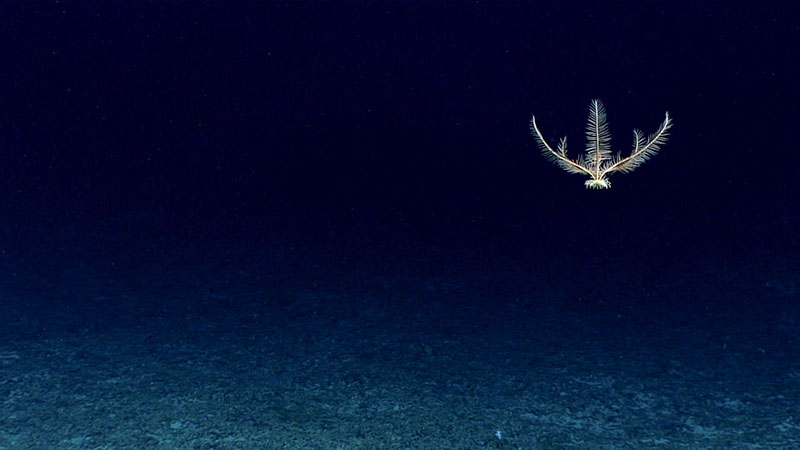
A specimen like this crinoid (Pentometrocrinus sp.) was collected during Windows to the Deep 2019. The only other specimen of this organism at the Smithsonian, which archives biological samples collected during Okeanos Explorer expeditions, was collected in 1963 and was not fully intact, making this collection very important to science. This may also be the first observation of this species swimming. Image courtesy of the NOAA Office of Ocean Exploration and Research, Windows to the Deep 2019. Download larger version (jpg, 916 KB).
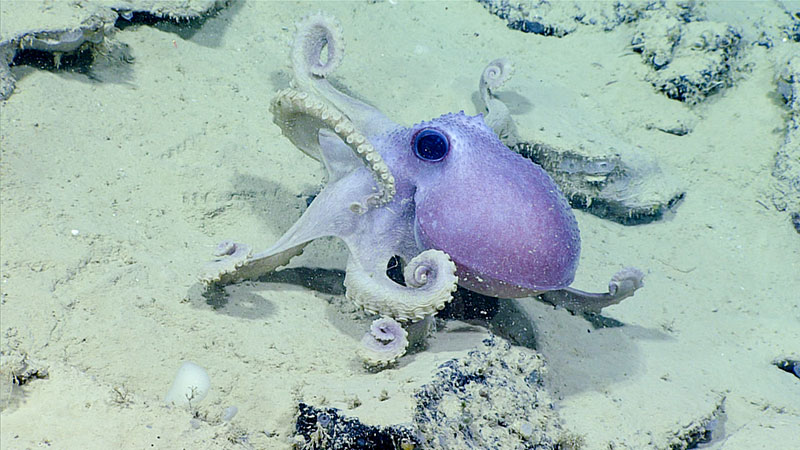
During Windows to the Deep 2019, the team encountered this octopus (Graneledone verrucosa) making its way across the seafloor. This octopus is nicknamed the "warty octopus" due to the cartilaginous bumps all over the mantle, head, and dorsal surface of the arms. Image courtesy of the NOAA Office of Ocean Exploration and Research, Windows to the Deep 2019. Download larger version (jpg, 1.4 MB).
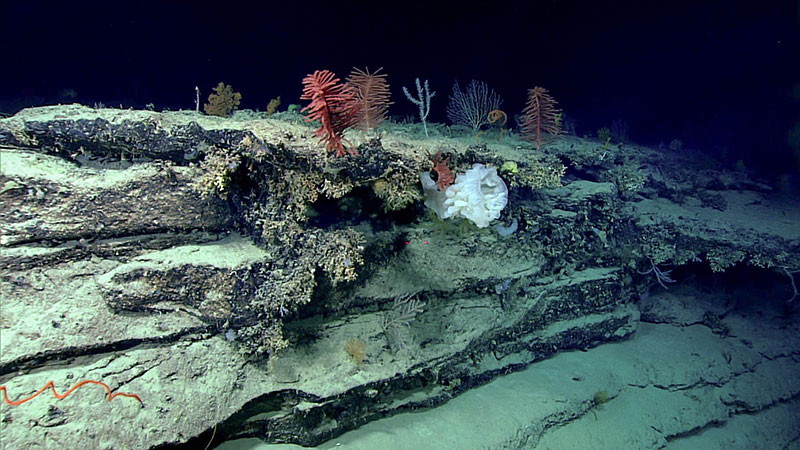
Prior to Windows to the Deep 2018, this section of the Blake Escarpment appeared to be an area of low slope with no distinct features. Images captured during the expedition show sponges, corals, urchins, and other organisms populating outcrops of hard substrate on the seafloor. Image courtesy of the NOAA Office of Ocean Exploration and Research, Windows to the Deep 2018. Download larger version (jpg, 872 KB).
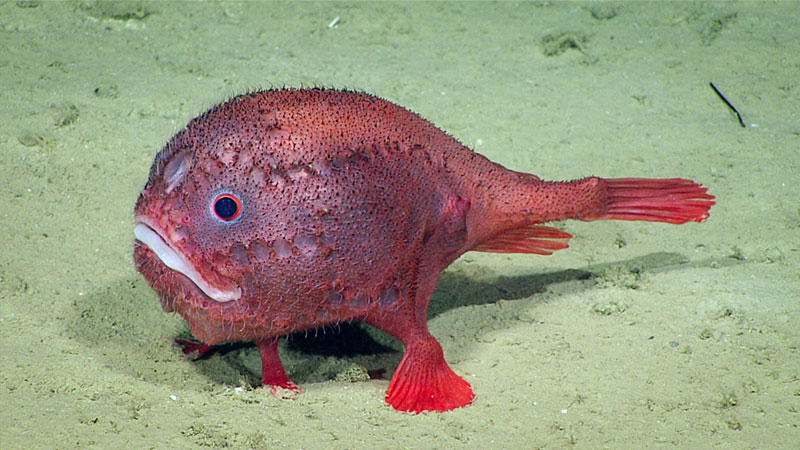
Anglerfish, in the genus Chaunacops, have a small lure on a short stalk between their eyes that they wiggle in order to attract prey. While often resting on the seafloor or "walking" on modified fins, as captured here during Windows to the Deep 2018, sometimes these fish do swim. Image courtesy of the NOAA Office of Ocean Exploration and Research, Windows to the Deep 2018. Download larger version (jpg, 852 KB).
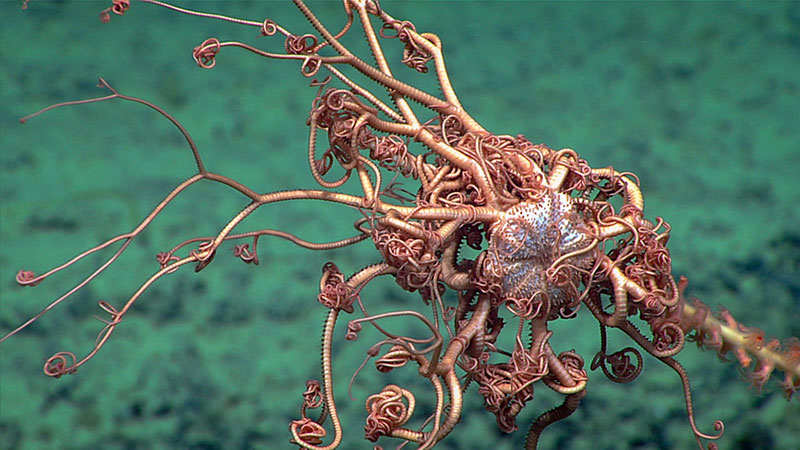
This basket star perched on a bamboo coral was observed during Windows to the Deep 2018. Image courtesy of the NOAA Office of Ocean Exploration and Research, Windows to the Deep 2018. Download larger version (jpg, 765 KB).
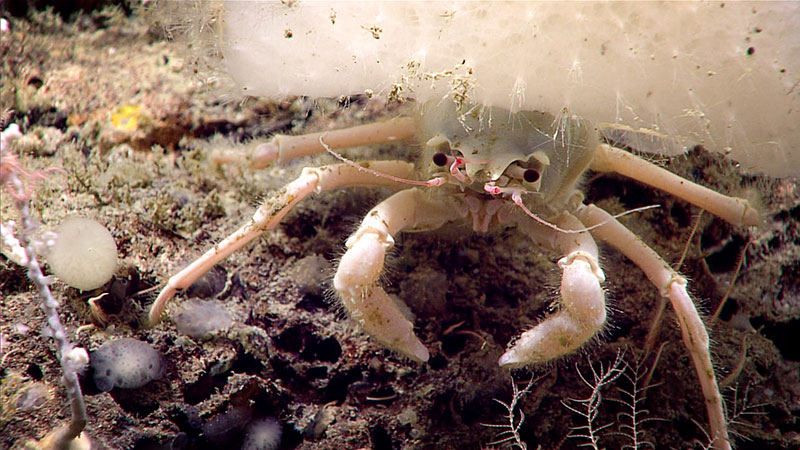
During Windows to the Deep 2019, we saw this crab holding a hexactinellid (glass sponge) on its back, using the sponge’s sharp spicules for protection. Image courtesy of the NOAA Office of Ocean Exploration and Research, Windows to the Deep 2019. Download larger version (jpg, 1.4 MB).
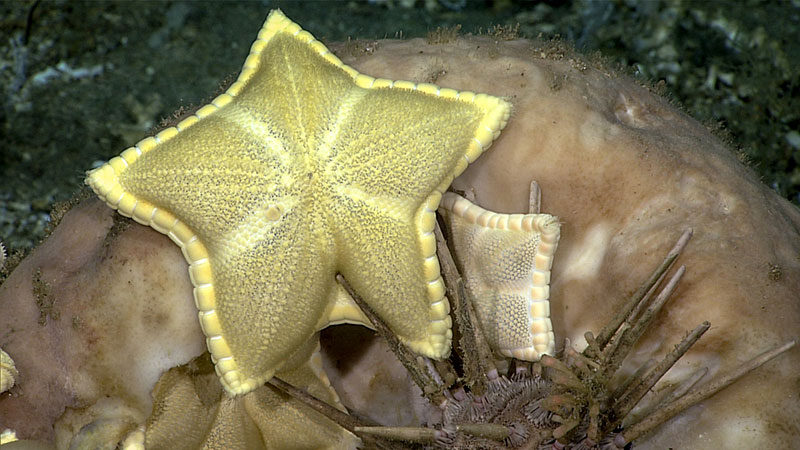
The goniasterid sea star Plinthaster dentatus, sometimes called a “cookie” or “ravioli” star, was literally one of the stars of Windows to the Deep 2019. These individuals are shown here with a cidaroid sea urchin and a sponge. Image courtesy of the NOAA Office of Ocean Exploration and Research, Windows to the Deep 2019. Download larger version (jpg, 1.3 MB).
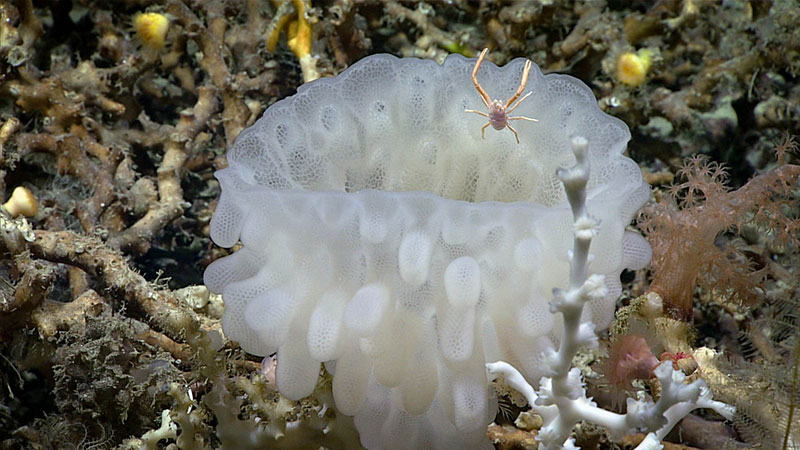
This squat lobster and glass sponge were seen during Windows to the Deep 2018. Image courtesy of the NOAA Office of Ocean Exploration and Research, Windows to the Deep 2018. Download larger version (jpg, 778 KB).
Ever consider how we get this incredible imagery? Well, we have the Okeanos Explorer’s expert team of pilots and videographers to thank. They use still and video cameras and lights on the ROVs Deep Discoverer and Seirios to capture images and video and transmit them to the ship, and then to shore by satellite, allowing us to explore the ocean without actually being in the ocean.
During Windows to the Deep 2018, we observed this lithodid crab, a type of king crab, feasting on a brittle star. While a bit graphic to watch, predation events such as this offer scientists unique glimpses into the lives and behaviors of animals of the deep. Though predation events like these often amaze us, we are still learning about which are truly rare and which are just rarely observed. Video courtesy of the NOAA Office of Ocean Exploration and Research, Windows to the Deep 2018. Download larger version (mp4, 44.0 MB).
From November 1 through November 20, tune in to our live daily dives. Join the excitement and experience the thrill of discovery. See what the scientists see when they see it — sometimes for the first time. If you can’t watch us live, don’t worry, we post some of our favorite photos and videos on this expedition website. So check back often, and read our daily updates to learn more about what we’re doing and seeing.
Can’t wait? Take a peek into the image and video galleries for Windows to the Deep 2018 and Windows to the Deep 2019.